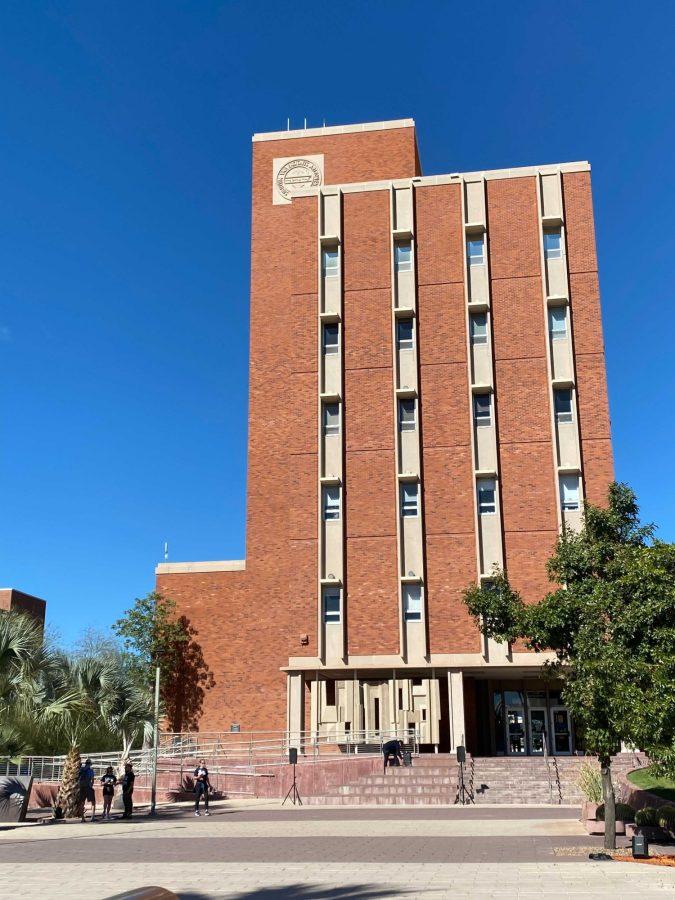About $9 million will fund performance-based raises for some UA faculty and staff, said UA President Ann Weaver Hart on Friday during her town hall meeting.
The town hall, held in Roy P. Drachman Hall, provided faculty, students and staff with the opportunity to address questions directly to Hart. Attendees were encouraged to ask questions on any topic of interest, including about the future of the UA and issues the university faces.
The first question from the audience dealt with the role of market disparity and equity with the new performance-based salary pool. Hart announced that a university-wide salary adjustment pool of $9.1 million had been established to fund performance-based salary increases for benefits-eligible faculty and staff funded on state and locally allocated budgets, in an email sent to UA employees Wednesday.
“My intention with this pool – and recognizing that it’s not a very big pool … is to focus on performance, but to make all employees who are performing at a satisfactory level eligible for an increase,” Hart said. “In other words, this is not designed to specifically go out to a small number of employees, faculty and staff at the university, but it’s designed to be the first overall, general performance-based … salary increase since 2007.”
Following the discussion on increased salaries, Hart answered several questions regarding the health sciences, such as what efforts the university is making to recruit students from Arizona to health professions programs and its residency and fellowship programs in medicine.
“To recruit students into our health professions programs at the undergraduate level, we are working very, very hard to identify and connect with high school students who are prepared to succeed,” Hart said.
There is nothing more devastating for a student than to borrow money, devote a year to school and a demanding major and then “wash out” and be left with debt, Hart added.
However, at the residency and fellowship level, the UA has to deal with a much more complex situation. The state of Arizona has a scarcity of Graduate Medical Education slots, according to Hart.
Hart said that she is working with political leaders in the state to create a specific GME strategy to make sure that the UA residency and fellowships are world-class. Hart said she is also working to make sure those programs have the right quality and reputation to retain graduates and interest them in positions in-state, as well as attract graduates from the health sciences to Arizona.
John Murphy, associate dean and professor of the Department of Pharmacy Practice and Science, asked Hart to think about the College of Pharmacy when talking about GME and residency programs, and how it might advance those types of programs in the state.
Hart added that coming to the UA, she understood that the UA Cancer Center and health sciences programs had a long way to go to reach the level of distinction the UA aspires to, especially considering that the policy environment for healthcare in the U.S. is currently in flux. However, she said did not understand just how much work there is to be done and how crucial it is for the UA to seize every opportunity to improve.
“The intensity of the challenges in the health sciences in general that we face as a community, to succeed, and not just succeed but with distinction, are pretty strong,” Hart said.
As the town hall began to wind down, some audience members expressed concerns about the rising cost of education.
“We see it all the time,” said Marty Baker, coordinator for recruitment and admissions for the College of Pharmacy. “Especially when we’re talking to those coming from high school, you know, at recruiting events, and you see parents, you see the eyes … because how in the world are they going to be able to afford an education, undergraduate, and then get their kids to a professional school?”
Baker then asked Hart for ideas on how to convince in-state and out-of-state students that school is still a possibility.
“I am committed to making sure that we do become better at providing high quality service for lower cost, without lowering our standards,” Hart said. “I also would appeal to you, when you talk to students, to help them and their parents be very sophisticated about ways to reduce cost.”
Overall, Hart said she thought the discussion was very insightful.
“I certainly learned a lot from the faculty and staff who came,” Hart said. “I was thrilled that they were willing to ask serious questions, and to share their experiences, and I hope that we have a chance to build an increasingly strong commitment to march forward together.”








